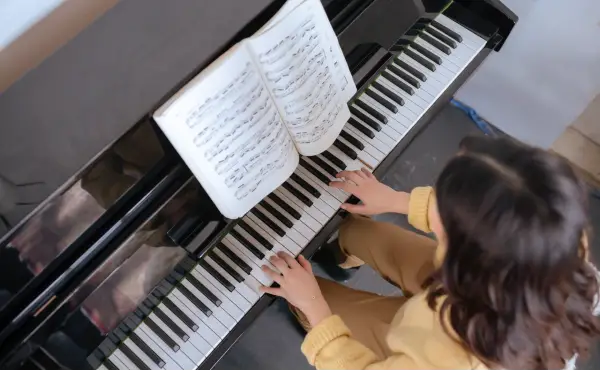- Home
- Piano Technique
- Learn How to Play Piano
Learn How To Play Piano Pain Free with Proper Posture
This article may contain compensated links. Please read the disclosure for more info.
Learn how to play piano without pain!
Are you tired of experiencing back pain while playing the piano? You're not alone. As a fellow pianist, I suffered from terrible neck pain until I learned the importance of proper technique and posture.
I was taught to push my elbows outwards, which eventually caused excruciating pain between my shoulder blades, making it impossible to practice without painkillers. However, by understanding how to sit correctly and increase my awareness of how to balance my body, I've learned that playing the piano can and should be pain-free.
Don't let pain stop you from enjoying your passion for piano playing. Learn how to improve your posture and play without discomfort, and enjoy your piano playing!
If you're an adult beginner learning how to play piano on your own, you might want to check out Piano For All. It's a resource that offers self-paced lessons so you can learn piano on your own schedule.
With its user-friendly approach, the resource provides a fun and engaging way to learn the basics of piano, such as reading sheet music, playing chords, and understanding rhythm.
Learn How To Play Piano The Right Way: Common Mistakes

Back and neck pain is a common problem among pianists, and there are several reasons for it. The good news is that most of these issues can be easily addressed with the right posture and technique:
- Sitting at the wrong height. One of the most common causes of pain is sitting at the wrong height. Your piano chair should be comfortable, and your upper arms' length determines your seat height, not your overall height. When your hands are in a cupped position on the keys, your upper and lower arms should form an approximate 90-degree angle. Using an adjustable piano bench can help avoid neck and back pain.
- Tense shoulders. Tense shoulders are another cause of pain. Your shoulders should be relaxed, and your arms should hang freely from them. Avoid pushing your elbows outwards or pressing them against your body. Do a quick exercise: Gently circle your shoulders a few times backward and forward. Finish by lifting your shoulders as high as possible, push back, and let them fall down.
- Balancing the body weight in the wrong way. Balancing your body weight incorrectly can also lead to discomfort. Make sure to sit at the front center of the bench with your feet firmly on the floor by the pedals. Your body should be balanced in three places; your bottom, feet, and fingertips. The rest of your body should feel elastic, free, and light.
- Make sure not to sit too close to the piano; Avoid sitting too close to the piano. You need space to use your torso to lean forward and sideways as needed while playing. By maintaining a natural and comfortable posture, you can learn how to play piano without pain and focus on improving your technique and musicality.
- Craning your neck. Tip: Videotape yourself to see if you are craning your neck when playing. Reasons could be poor eyesight, insufficient light, and where the notes are placed before you. The note stand is positioned higher on a grand piano than on an upright piano; it is also adjustable. If you practice at an upright piano and constantly tilt or push your head forward to read the notes, this might cause you pain. One remedy could be to put something under the sheet music books so they are lifted up more in front of your eyes.
- Too low or too high wrists. Another common factor is keeping your wrists too low or too high when you play, which can break the "balance" points and strain your wrists, leading to pain up your arms and shoulders. It is important to keep your wrists elastic and free, unifying the arm and hand in an unbroken line.
- Not taking regular breaks. Taking regular breaks while stretching gently is also crucial to prevent repetitive strain injury (RSI). Make sure to take short and frequent breaks while you stretch softly. It can be so easy to ignore the dull aches and play just a bit more... But, this can build up over time and lead to injuries that are difficult to heal.
TIP: Special piano cushions, such as an orthopedic "Tush-Cush," are available to help relieve pressure on your spine. These cushions can help you sit at the correct height and enable you to sit with a slight angle forward, which helps balance your weight and reduce pain.
Correct Seat Height
The Taubman-Golansky Institute is a game-changer for professional pianists who suffer from RSI. Their innovative approach to retraining the body for pain-free playing has helped countless musicians reclaim their careers.
Repetitive Strain Injuries are a common problem among pianists and can range from mild discomfort to severe pain. Fortunately, the Taubman-Golansky Institute's technique addresses the root causes of RSI, such as tension and incorrect movements, enabling musicians to learn how to play piano with ease and joy.
For aspiring pianists, learning how to sit at the correct height at the piano is essential for preventing back pain and other posture-related issues. In this video, you'll find helpful tips on how to adjust your seat height and footrest to maintain optimal posture and avoid discomfort:
Potentially Harmful Technical Habits
If you're an aspiring pianist, you know how important it is to have the correct posture when playing the piano. Poor posture can lead to neck and back pain, which can eventually interfere with your ability to play.
Luckily, there are resources available that can help you learn the proper technique to play piano without discomfort. One such resource is the "Freeing the Caged Bird" video by Barbara Lister-Sink.
This video offers tips and insights on how to play piano with correct posture, which is essential for injury prevention. Lister-Sink's technique is founded in the Alexander Technique, a method that promotes body awareness and helps musicians improve their posture, balance, and overall performance.
Get a Comfortable Piano Bench
When it comes to playing the piano, many people overlook the importance of a proper bench. As a pianist myself, I know firsthand how critical a comfortable and adjustable piano bench can be for maintaining the correct posture and technique. Poor seating can lead to back pain, fatigue, and ultimately impact your performance.
I highly recommend visiting your local piano store to try out different benches and find the one that fits your needs. You want a bench that provides stability, adjustability, and comfort, allowing you to maintain an optimal playing position for extended periods.
Alternatively, check out my recommended Adjustable Piano Benches for the best piano chairs. These benches offer various features like height and angle adjustments, padding, and ergonomic design.
Investing in a high-quality piano bench is not just about comfort but also your long-term health. Don't let poor seating prevent you from enjoying your passion for playing the piano. Take the time to find a bench that suits you, and enjoy playing comfortably and pain-free for years to come.





